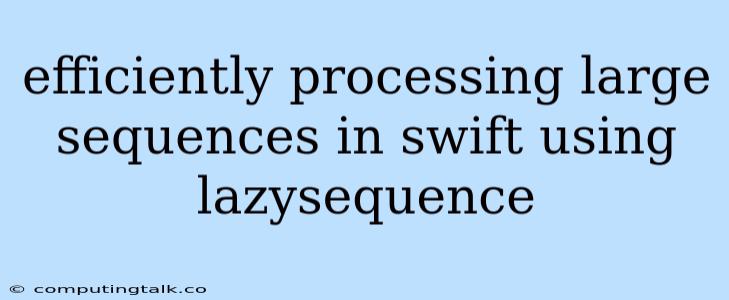Swift is a powerful and versatile language, known for its performance and ease of use. When working with large sequences of data, however, efficiency becomes paramount. LazySequence in Swift provides a powerful way to process large sequences without loading the entire dataset into memory at once. This approach can dramatically improve performance and reduce memory usage, especially when dealing with massive datasets.
Understanding Lazy Sequences
At its core, a LazySequence is a sequence that generates its elements on demand. Instead of calculating all elements upfront, it only computes elements when they are requested. This lazy evaluation is particularly beneficial when dealing with large datasets, as it avoids unnecessary computation and memory allocation.
How LazySequence Works in Swift
Let's illustrate the concept with an example. Imagine you have a very large array of integers and you need to find the sum of all even numbers. A traditional approach would iterate through the entire array, checking each element for evenness and adding it to a running sum.
let numbers = [1, 2, 3, 4, 5, 6, 7, 8, 9, 10]
var sum = 0
for number in numbers {
if number % 2 == 0 {
sum += number
}
}
print(sum) // Output: 20
This approach, while straightforward, can be inefficient with large arrays. LazySequence offers a more efficient way to achieve the same result.
let numbers = [1, 2, 3, 4, 5, 6, 7, 8, 9, 10]
let evenNumbers = numbers.lazy.filter { $0 % 2 == 0 }
let sum = evenNumbers.reduce(0, +)
print(sum) // Output: 20
In this code, lazy creates a LazySequence from the numbers array. The filter method, applied to the LazySequence, only evaluates elements when they are needed. It filters out odd numbers, and only even numbers are passed to the reduce method.
Benefits of Using LazySequence
Using LazySequence in Swift offers several advantages:
- Memory Efficiency: LazySequence only calculates elements when requested, avoiding unnecessary memory allocation. This is especially useful when working with large datasets that would otherwise strain memory resources.
- Performance Optimization: By avoiding unnecessary computation, LazySequence can significantly improve performance. This is particularly important for operations that involve complex calculations on large sequences.
- Flexibility: LazySequence allows you to chain operations together, creating complex data transformations without loading the entire dataset into memory.
- Deferred Evaluation: Operations on LazySequence are evaluated lazily, meaning they are only performed when the result is actually needed. This allows for greater flexibility in controlling the execution flow.
Practical Applications of LazySequence
LazySequence can be applied in various scenarios where efficient processing of large sequences is crucial. Examples include:
- Data Filtering: Filtering large datasets based on specific criteria, such as selecting only relevant records or removing duplicates.
- Data Transformation: Transforming large datasets by applying operations like mapping, sorting, or grouping.
- File Processing: Reading and processing large files line by line, avoiding loading the entire file into memory.
- Network Operations: Handling large amounts of data received from a network stream, processing data incrementally.
Tips for Efficiently Using LazySequence
Here are some tips for leveraging the power of LazySequence effectively:
- Chain Operations: Combine multiple operations on LazySequence to perform complex transformations in a single pass.
- Avoid Unnecessary Operations: Use
lazyonly when needed, as it can introduce a small performance overhead compared to regular sequences. - Understand Lazy Evaluation: Be aware of when operations on LazySequence are executed, as they are deferred until the result is required.
Conclusion
LazySequence in Swift is a powerful tool for efficiently processing large sequences of data. By using LazySequence, you can achieve significant performance and memory optimizations, making it an indispensable technique for handling vast datasets in Swift applications. By embracing lazy evaluation and its associated benefits, you can unlock the potential of Swift to work with large amounts of data with ease and efficiency.
